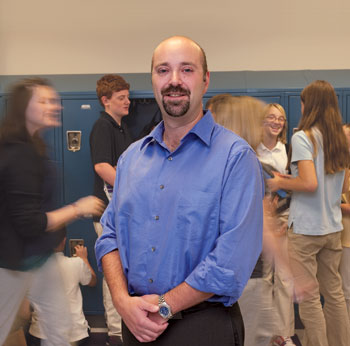Lots of security in schools but zero tolerance

RESEARCH | Ask Aaron Kupchik, associate professor of sociology and criminal justice, what’s wrong with today’s school discipline tactics, and he has a simple answer: “We don’t listen to kids.”
Authorities have become “so wedded to these rules and very harsh punishments that we’ve forgotten how to use rules to help kids,” says Kupchik, who examines the issue in a new book, Homeroom Security: School Discipline in an Age of Fear. In it, he explores such disciplinary practices in schools as assigned police officers, drug-sniffing dogs, metal detectors, armed security guards, surveillance cameras and zero-tolerance policies.
Kupchik spent time inside four schools in two states observing teachers, administrators and students. Two of the schools are located in the Southwest, and two are in the Mid-Atlantic region. In each state, one school’s student body is mostly middle-class white students and one school’s population is composed of mostly lower-income minority students.
Kupchik found that discipline was doled out similarly in all four schools.
“When students got in trouble, the people in charge of discipline didn’t ask questions about why they got into trouble or didn’t try to solve their underlying problems,” he says.
Instead, disciplinarians followed what Kupchik calls excessive and counterproductive strategies for dealing with students’ misbehavior, one of the worst of which is the popular notion of zero tolerance, policies that assign a certain punishment to an infraction regardless of circumstance.
Kupchik argues that while the sentiment behind zero tolerance is admirable—treating students equally—in practice, it becomes irrational. He points to cases nationwide of students receiving suspensions and even jail time for infractions such as wearing a certain T-shirt or pushing a hall monitor.
“Tolerance used to be something good we wanted to teach students, and now we’ll have zero of it in our schools,” Kupchik says.
What are abundant in schools are security officers. According the National Center for Education Statistics, in 2007, 68.8 percent of 12- to 18-year-olds reported that either a security guard or police officer was assigned to their school.
While noting their necessity in schools with serious violence problems, Kupchik says he believes that in the majority of American schools, police officers are a negative presence. He notes that officers’ skill sets do not translate well to a school environment, saying their methods for dealing with conflict are often aggressive, which can escalate situations, potentially turning nonviolent, minor situations into violent scenes ending in arrests.
Homeroom Security outlines suggested strategies, rooted in empirical data, for making schools safer. Among them are mandatory tutoring rather than suspension, since students often act up in class when they have trouble understanding lessons, and involving students in rule creation.
Today, schools are notably safer than they were two decades ago. National statistics show rates of violent crime and victimization on the decline. Yet, school discipline tactics trend in the opposite direction, increasing and becoming harsher.
Kupchik hopes his book will spark policy debates, with decision makers listening to proposed solutions and to the people they affect—the kids.
Homeroom Security is published by New York University Press. Research contributed to the book was funded by a grant from the National Science Foundation.
Kupchik has discussed more about his findings in a video; visit www.youtube.com and search for his name.
Article by Andrea Boyle, AS ’02





